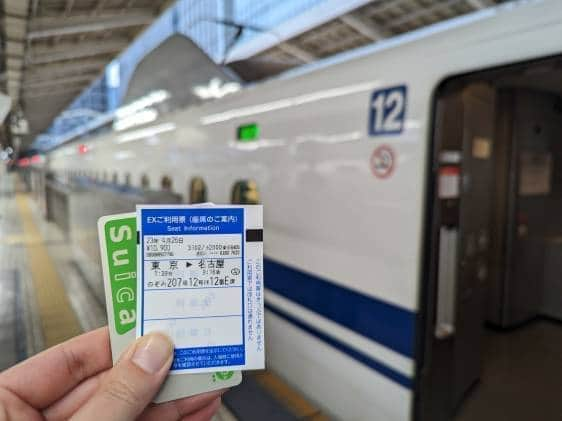Autumn is one of the most stunning seasons in Japan, drawing visitors from near and far to see the vibrant colors of kōyō (the changing of the leaves). But where are the most magnificent trees hiding? We did some sleuthing. From ancient specimens that are 700-year-old to those with uniquely twisted roots — here are eight utterly fabulous trees in and around Tokyo.
Pro tip: Want to escape the city? Consider one of these 9 popular autumn day trips.
Before we begin, a little caveat: We visited as many of these trees as possible — in many cases more than once — to confirm that they are as awesome as they seemed in the sources. For those we could not get to this year, it’s worth keeping in mind that things might have changed.
Also, make sure to keep up to date with the 2024 fall foliage forecast so you don’t miss the best colors!
1. Azabusan Zenpukuji
MinatoSaid to be home to the oldest tree in all of Tokyo, Azabusan Zenpukuji Temple is where you’ll find an ancient 750-year-old ginkgo tree that certainly lives up to its status as a natural monument of Japan. Although it is only 20 meters tall, which is considered average, its trunk circumference is an impressive 10 meters. It is said that the Buddhist monk Shinran planted his staff (a walking stick or a ceremonial staff) in a random spot, and it began to grow buds and branches, eventually becoming the famous ginkgo tree.
This majestic ginkgo is fondly known as Sakasa Icho (the upside-down ginkgo tree) because its roots are shaped differently from other ginkgo trees. Unfortunately, it has lost some branches and its original shape due to damage from the Great Yamanote Air Raid in 1945. If you look at the back of the tree, you’ll see a large section has been burned. For many, this tree symbolizes not only resilience, but also serves as a tangible reminder of history.
The nearby Azabu Jūban neighborhood also has a lot to offer, with trendy cafés and boutique shops. If you venture a bit further and take a 15-minute walk, you can visit Roppongi Hills — a business park where you can shop, admire art, and dine. You can easily transform your visit to this famous tree into a full day of sightseeing and shopping.
2. Kishimojindo Temple
ToshimaKishimojindo Temple in Toshima is not only a renowned site for praying for safe childbirth, but also has a remarkable ginkgo tree that graces its grounds. The tree is believed to have special powers that help with fertility and raising children. With a trunk circumference of 6.63 meters and a height of 32.5 meters, it’s no surprise that this ginkgo tree is a natural monument in Tokyo. It is also said to be the second-largest ginkgo in Tokyo, having lost first place to the Zenpukuji tree.
The Kishimojin ginkgo was initially recognized as a national natural monument in 1930, but this changed in 1946. Fortunately, it was later reclassified as a natural monument, but only in Tokyo. To add to this, this tree has a long and mystical history. Legend has it that a monk planted it during the Ōei period (1394–1428), making it older than the temple itself, which was built in 1578.
After visiting this tree, you can always walk 15 minutes (or take the cute tram for 5) to Ikebukuro, known for Sunshine City and the biggest Animate store in the world. There is also a solid selection of restaurants, izakaya and cafés, making it easy area to spend a good few hours.
Pro tip: For more inspiration, check out 10 Fun Things to Do in Ikebukuro.
3. Shiba Toshogu
MinatoTucked away in one of Tokyo’s oldest public parks, Shiba Park, is Shiba Toshogu Shrine. Here, you’ll find a centuries-old ginkgo tree, believed to have been planted by Tokugawa Ieyasu, the first shōgun of the Tokugawa shogunate in Japan. This tree is also listed as one of Tokyo’s Natural Monuments, as of 1956.
According to the Tokyo Cultural Heritage Map, this ginkgo tree, which is east of the Shiba Maruyama tomb, is estimated to be around 350 years old. It shares a similar trunk circumference to the ginkgo at Kishimojin Temple, measuring 6.5 meters, yet it is only 21.5 meters tall in comparison. In addition to housing one of the tallest trees in Tokyo, Shiba Park — where the shrine is located — also offers an appealing blend of modern and traditional landscapes.
If you are a photographer wanting to capture stunning autumn shots, this is the perfect spot. Head to the east side of the shrine. Here, you can frame the sacred ginkgo tree with Tokyo Tower in the background. While you’re in the area, be sure to explore the park and the renowned historic site of Zōjōji Temple.
4. Hibiya Park
ChiyodaHibiya Park is one of the most cherished spots in Tokyo for viewing autumn leaves. Despite the park being full of gingko trees, there is one which really stands out. Often referred to as the “Risky Ginkgo Tree” and Kubi-kake (head stake), this ginkgo is estimated to be around 400-500 years old. With a trunk circumference of 7 meters and a height of 20 meters, this tree is best appreciated from the terrace of Hibiya Matsumotoro, a Western restaurant.
Around 1899, the tree was scheduled to be cut down for the expansion of Hibiya Street. However, the park’s main designer, Dr. Seiroku Honda, vowed to relocate the tree “even if my head is put on a stake”. Despite skepticism, the tree was successfully moved 450 meters to its permanent location in the park in just 25 days.
Take the time to enjoy a leisurely stroll through this Western-style park. With its diverse array of autumn trees, it’s the ideal spot for taking photos and getting into the autumn atmosphere. After this, you can explore the wider Hibiya area and even stroll towards Tokyo Imperial Palace.
5. Shōbōji
Saitama1 hour 15 minutes from Ikebukuro Station
Perhaps the most magical-looking tree on this list, the legendary gingko at Shōbōji Temple is one definitely worth making the journey for. Along with being one of Saitama’s natural monuments since 1974, it is unofficially considered to be one of the best three gingko trees in all of Japan. Part of its charm is its extraordinary shape and twisted roots. Believed to be roughly 700 years old, with a trunk circumference of 11 meters and an approximate height of 25 to 30 meters, it’s no wonder that visitors are in awe when they see this tree.
Apparently, several different trees have merged together to form the unique roots. During the Edo period, the tree was referred to as Yoro-ki and was worshipped by numerous women, who saw it as a protector of safe childbirth. Similar to the ginkgo at Azabusan Zenpukuj, this one has survived a few natural disasters. Around early December, when the leaves are at their most golden, Shōbōji hosts the Kannon Festival, as well as a special light-up event during which the tree glows at night.
Near Shōbōji are a few smaller shrines and temples to explore. Additionally, a 5-minute walk from the temple will lead you to Monomiyama Park, a pretty wild hilltop park (think wild-boar and snake warning signs) that is great for viewing autumn leaves, especially momiji (Japanese maples).
Note that the entrance to Shōbōji is via an underground tunnel beside the road. Monomiyama Park is on the opposite side of the road.
For more information on Shōbōji, check out the detailed write-up on In Saitama.
6. Saizenji Temple
Saitama2 hours 30 minutes by train from Shinjuku Station
If you love vibrant red maple leaves, you’ll be amazed by this tree at Saizen-ji Temple. This 600-year old Japanese snakebark maple has a trunk circumference of 3.8 meters and a height of 7.2 meters. Although it is not the tallest tree, its branches sprawl across a circumference of 56.3 meters. Like some of the other trees mentioned, this maple is also a prefectural natural monument.
Many people come to pay their respects and see the tree during the autumn season. At this time, there is normally an admission fee of ¥100. Saizenji is the eighth site on the Chichibu 34 Kannon Pilgrimage — a multi-day Buddhist temple pilgrimage that spans Chichibu, Yokoze, Obano, and Minano.
There isn’t much else in the immediate area, aside from a few smaller shrines and a soba shop. That said, Komatsuzawa Leisure Farm is just a 5-minute drive away. Saizenji Temple is also just a short bus ride from Chichibu Station, making it easy to have a full-day trip to see this tree and historic city.

7. Shoryuji
Saitama2 hours 10 minutes by train from Shinjuku Station
Situated on a slope behind the main hall of Shoryuji are two uniquely shaped weeping maple trees. Although these trees are natural monuments in Saitama, they are actually second-generation trees. The location where they now stand was once home to a 300-year-old maple tree, which was also a natural monument but eventually died. Although these two maple trees are significantly shorter, measuring 3.8 and 4.6 meters in height, it is their hemispherical shape that set them apart from the rest.
There is no bus that takes you directly to this shrine, meaning to visit you will need to take a 24-minute walk from Yorii Station. Shoryuji is one of the eight sacred shrines in the area dedicated to the “Guardian Deity of the Zodiac”. Many people take the two-hour route to visit each temple, collecting an exclusive goushin (shrine stamp) from each for ¥300 along the way.
If you head back to Yorii Station and take a bus to Akiyama, you can trek up to the Tyugendaira Green Park Observation Deck, which gives you a panoramic view of Yorii town, as well as Mount Tsukuba, Mount Nantai, and Saitama City.
8. Kobayashi Maple Garden
Saitama1 hour 10 minutes by train from Shinjuku Station
Considered a hidden gem for autumn-leaf viewing, Kobayashi Maple Garden is a picturesque landscape garden in Kawaguchi. While there isn’t a majestic, monumental tree here, visitors can feel sheltered by the gracefully curved maple tree in the gardens.
As you stroll through the gardens, you’ll encounter 400 varieties of maple trees, each displaying striking leaves in shades of red, yellow, and green. Notably, these gardens also have a shop where you can purchase your own momiji. From small seedlings to larger trees, it’s an excellent place for those living in Japan to come and shop for some plants.
Although you can take a bus to Kobayashi Maple Garden, it is much easier to drive there. Doing this means you can easily access other local destinations, such as Kawaguchi City Green Center — a city park and botanical garden. Visiting both Kobayashi Maple Garden and Kawaguchi City Green Center offers a delightful day trip for nature enthusiasts.

Tokyo autumn trees FAQs
What are the Japanese trees in autumn?
Japan is home to a variety of stunning autumn trees. However, the most recognizable and symbolic are momiji (Japanese maple), kaede (maple), and ginkgo. Other trees you’re likely to encounter during this season are karamatsu (Japanese larch), Japanese beech, Mongolian oak, birch, and redvein enkianthus — just to name a few.
How long does autumn foliage last in Japan?
This can change from year to year. In the past, the autumn foliage season typically began around mid-September to mid-October. However, in 2024, the Japan Meteorological Corporation forecasts that the foliage will peak in late November to early December. It’s possible that this trend may continue in coming years.

Sources:
- Tokyo Metropolitan Government
- Toshima City official website
- Azabu Community Information Paper
- Yokoze Town Tourism Association
- Visit Minato City Official Visitor Guide
- In Saitama
- show-en-kei.com
- Jana47
- anon.lolipop.jp
While we do our best to ensure it’s correct, information is subject to change. All photos by Jane Pipkin and Carey Finn.




















































